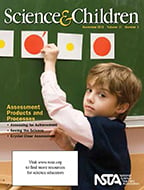Assessment products and processes
By Mary Bigelow
Posted on 2013-11-07
 What is the purpose of an assessment? The featured articles in this issue show assessment as a true part of the instructional process, not an add-on to get a score for a grade. As I read the articles, I was impressed at how the assessments were designed to match the learning goals and the instructional content.
What is the purpose of an assessment? The featured articles in this issue show assessment as a true part of the instructional process, not an add-on to get a score for a grade. As I read the articles, I was impressed at how the assessments were designed to match the learning goals and the instructional content.
This approach to assessment is described in Assessing for Achievement.* The authors show how formative assessments can be included in each phase of the 5E Instructional Model during a lesson on mixtures and solutions. The authors include samples of student handouts, and their chart showing examples of assessment for each phase of the Model is a wonderful resource for any teacher and any topic. [SciLinks: Mixtures, Solutions] Is It Melting?* (Formative Assessment Probes) has a tool for examining students’ ideas about physical changes in matter (and has an interesting discussion of the difference between melting and dissolving). [SciLinks: Physical Changes, Dissolve]
The first paragraph of Crystal Clear Assessment* should be required reading for educational decision-makers, including the sentence “An effective teacher creates a student-centered learning experience that links essential concepts and skills to students’ current understanding and natural curiosity about the topic.” The authors apply their understandings about students and learning to a 5th grade chemistry unit, using student-designed experiments as a summative activity (rubrics are included). [SciLinks: Physical Properties of Matter]
During a lesson on simple machines, the students featured in Simply Performance Assessment* used basic, inexpensive materials to demonstrate their understanding and use their creativity. The article includes rubrics, a list of materials provided to the students, cooperative learning roles for each team, and photos of some final projects. If you need more background, this month’s Science 101 column is What is the Physics Behind Simple Machines? [SciLinks: Simple Machines]
Do you have students who love to “perform” in class? The authors of …And Action!* describe a skit their students created to show their understanding of electricity. The skit also showed off their skills in writing and performing as a way of communicating. The article includes rubrics, photographs of students in action, and a discussion of how these skits were learning and assessment opportunities. [SciLinks: Magnets]
As the authors of Seeing the Science note, English language learners have two challenges in the science classroom: learning science and learning English. They describe a rubric they developed to assess ELL students’ written observations and include examples of student work. The article also includes strategies for supporting these students as writers and scientists. The unit focused on plants, but the rubric could be modified for other topics. Speaking of plants, this months Teaching Through Trade Books column, Pondering Plants*, has trade book and lesson suggestions for engaging K-2 and 3-5 students in a study of parts of a plant, observing plant growth, and investigating factors that affect plant growth. [SciLinks: Factors Affecting Plant Growth, How Do Plants Grow?, Parts of a Plant]
Models (designing, developing, and using) are an important features of the NGSS. This month’s Engineering Encounters column describes how to capitalize on elementary students curiosity and enthusiasm for dropping things (in this case, parachutes!] Who wouldn’t enjoy and learn from this type of activity? And this month’s Early Years column, Are They Getting It?* also has an engineering focus in which students experience a variety of materials and then design a container for food items. The article and lesson note that formative assessment can be as basic as watching students at work and interacting with them with open-ended questions. [SciLinks: Engineering Structures]
The kindergarten class in Scoring a Goal for Learning used a soccer analogy to guide their teamwork toward meeting a learning goal. The lesson included activities for students to reflect, observe, record, and discuss—all of which are opportunities for formative assessment by teachers (and self-assessment by students). The author of The Sun Is a Star? describes his experiences as a college instructor with a group of third-graders and their misconceptions. He offers suggestions for using these misconceptions and misunderstandings as opportunities to help students “develop their capacity to make sense of scientific ideas.”
* Many of these articles have extensive resources to share, so check out the Connections for this issue (November 2013). Even if the article does not quite fit with your lesson agenda, there are ideas for handouts, background information sheets, data sheets, rubrics, and other resources.
Disclaimer: The views expressed in this blog post are those of the author(s) and do not necessarily reflect the official position of the National Science Teaching Association (NSTA).

